By Virginia Marshall
Where Fort Creek enters the St. Marys River just below the historic locks at Sault Ste. Marie Canal National Historic Site, it’s a shallow channel scarcely broad enough to turn a canoe around. Bridged by boulevards and hemmed by sidewalks and parking lots, the creek disappears altogether for much of its course, buried and nearly forgotten beneath the city above.
On a warm spring evening, I witness a very different Fort Creek, winding through a verdant wetland filled with the sunset songs of veery, Swainson’s thrush and ovenbirds. A contented beaver navigates the meanders, watchful Canada Geese periscope from grassy banks. Perched above downtown, Fort Creek Conservation Area is a remarkable green space within the city.
The way Lake Superior Watershed Conservancy Executive Director, Joanie McGuffin, explains it, Fort Creek is both a living waterway and an allegory for the unseen connections that bind past to present, and culture to ecology.
Revealing hidden connections—between rivers, lakes, watersheds, communities, cultures, people and the planet—is the focus of a new visitor experience developed by the Lake Superior Watershed Conservancy in partnership with the Huron-Superior Regional Metis Community.
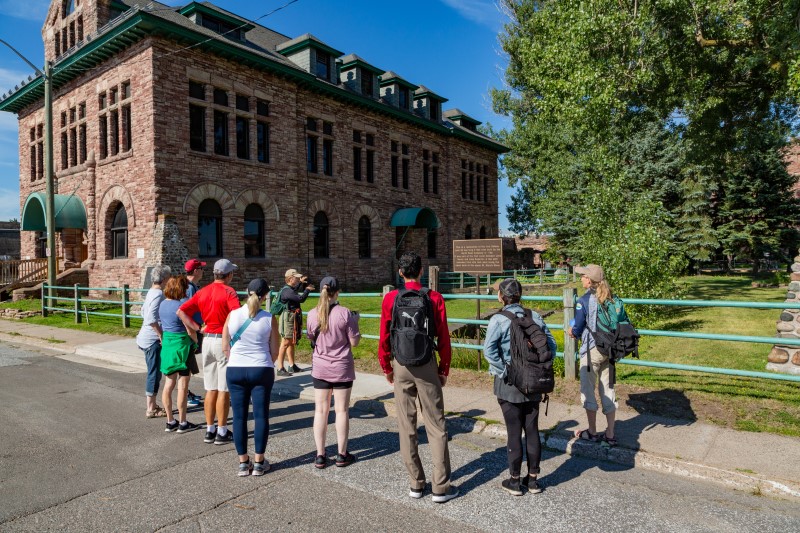
These interpretive tours provide visitors to Sault Ste. Marie with an exciting new way to discover the city, while making meaningful connections to the Soo’s vibrant Indigenous culture and heritage. Historic images, maps and hands-on materials add texture and context, transforming a modern cityscape into an historic gathering place, and an industrialized urban waterfront into a richly interconnected ecosystem.
For generations, the land that is now downtown Sault Ste. Marie was home to a thriving Métis community. The community was organized into river-lots that gave each family access to the river for travel, harvesting and economic activity. Families kept their animals communally in the area behind their homes and harvested maple sugar in spring along the escarpment. In the mid 1850s, Métis families were displaced from their lands, breaking promises by the Crown agent that their lands would be protected. Despite this injustice, the community continues to call Sault Ste. Marie home.
By sharing Métis perspectives on reciprocity and sustainable practices, the interpretive tours also advance the Lake Superior Watershed Conservancy’s work to promote watershed awareness and greater environmental understanding.
“The Métis story inextricably connects culture with ecology,” says McGuffin. “Indigenous people have been able to live with the land and care for our water for thousands of years, because it’s been a reciprocal relationship.”
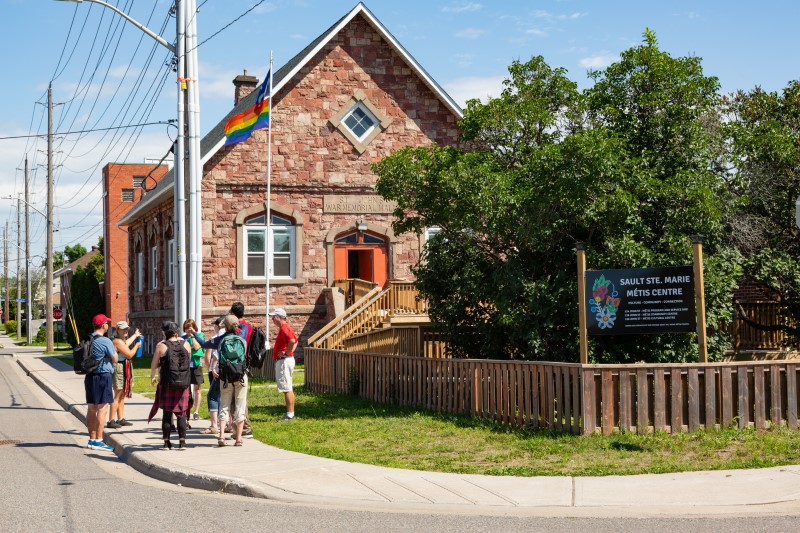
Tour participants can choose to join a Walking Tour or get on the water with a Walking & Paddling Tour. Both tours travel to the city’s scenic waterfront from the Sault Ste. Marie Métis Cultural Centre—a first of its kind in Ontario. Tours last two hours and are led by a Métis interpretive guide, giving visitors a fascinating glimpse into traditional and contemporary Métis life.
Paddling Tour participants board a Big Canoe—a replica of the 36-foot birch-bark canoes that once freighted furs and trade goods between Montreal and Lake Superior—to learn how the St. Marys River is central to both the story of Sault Ste. Marie, and the Indigenous communities who live here.
McGuffin believes passionately in the power of the Big Canoe to bring people together to share ideas and cultural understanding. In 2019, the Conservancy founded a new program called Canoes for Conservation, and she points to the Big Canoe’s stability, inclusivity and accessibility for non-paddlers and multi-generational groups of all ages.
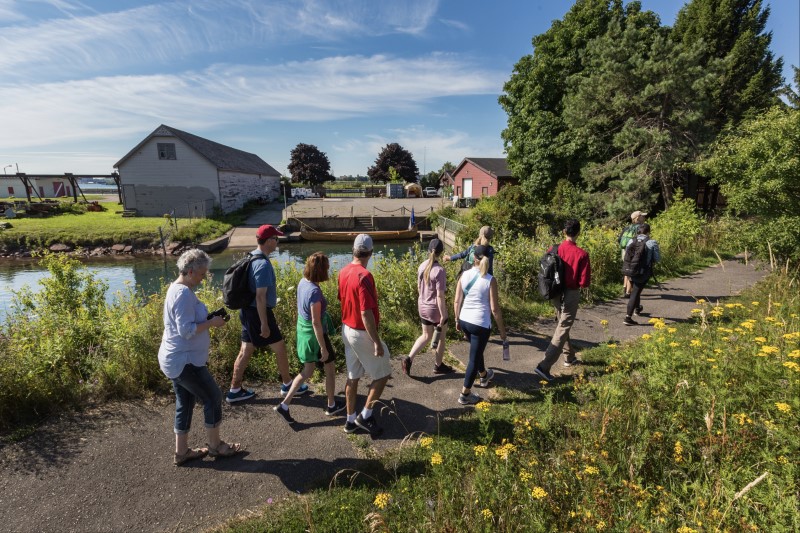
A highlight of the hour-long canoe portion of the journey is “locking through” the historic Sault Canal. Paddlers then venture onto the mighty St. Marys River—comparable in size and power to the Niagara River—feeling the spray of the rapids and the tug of the current beneath their hull. “It’s very tactile,” says McGuffin, “you have a paddle in your hands, you’re able to feel the water, listen to the water. It’s incredible how far into the rapids you can go—people are amazed by the experience.”
For the Métis Nation of Ontario, the tours are “an outstanding opportunity to grow Indigenous tourism in the north and advance reconciliation,” says community leader, historian and MNO Huron-Superior Regional Councillor, Mitch Case.
“In order to have that reconciliation conversation, Canadians need to understand who we are and what matters to us as a community,” he continues. By connecting across cultures, “we are protecting and preserving our unique heritage and world view.”
Lauren Towell is one of five young Métis community members who joined the interpretive guide team this summer. “The connections I share with the water resonate profoundly with the very fabric of my Métis heritage,” she says. “I take great pride in the task of sharing our story, ensuring that it endures for generations to come.”
Walking tour guide, Jake Chalmers, agrees, “Caring for our forests and wildlife is integral to caring for our Métis culture. Being a tour guide helps me to celebrate and share knowledge about both.”
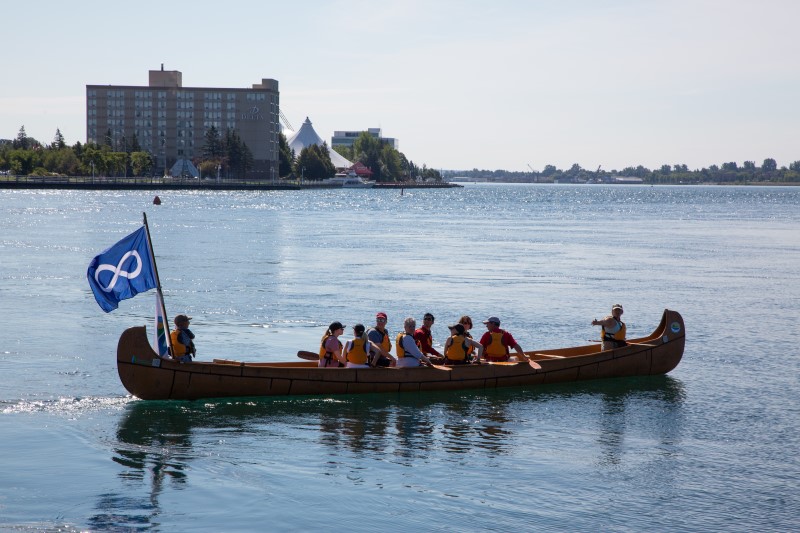
The tours visit numerous sites of great importance to the Métis community. In just a couple short hours, participants come to understand how connection to the river and love for their ancestors empowers the Métis community here—and what it can teach all of us.
For those visiting the city for the first time, the interpretive tours are also a great way to discover the Soo’s top scenic and cultural attractions.
As we stroll towards the river and the leafy promenades of Parks Canada’s Sault Ste. Marie Canal National Historic Site, McGuffin and I pass the Agawa Canyon Tour Train Station and Algoma Conservatory of Music. Housed in a refurbished, century-old sandstone building of the former St. Marys Paper Mill, The Loft is reported to have acoustics rivaling Massey Hall.
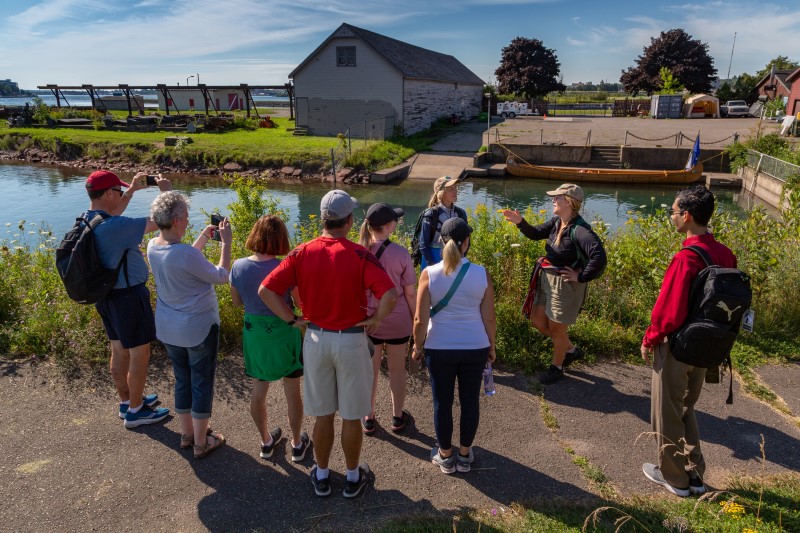
Outside, we see a re-creation of the rudimentary locks the voyageurs used to shuttle their Big Canoes around the Whitefish Rapids. Nearby, the weekly Mill Market hosts local food vendors and artisans where a Hudson’s Bay Company Post once stood.
As we walk, McGuffin tells me about the hidden river, where Fort Creek flows unseen beneath the city. She relates how downtown Sault Ste. Marie, from Bay Street to the river, is built entirely on reclaimed shoreline. “It’s not just about what we can see, it’s also what we can’t see,” she says. “When we don’t look at where water comes from and where it goes, we feel no responsibility for what happens along its journey.”
Before returning to the Métis Cultural Centre, we pause at the mouth of Fort Creek, marveling at the resilience and tenacity of water. The story of a people can be like a river that way—sometimes unseen, but always flowing steady and strong.
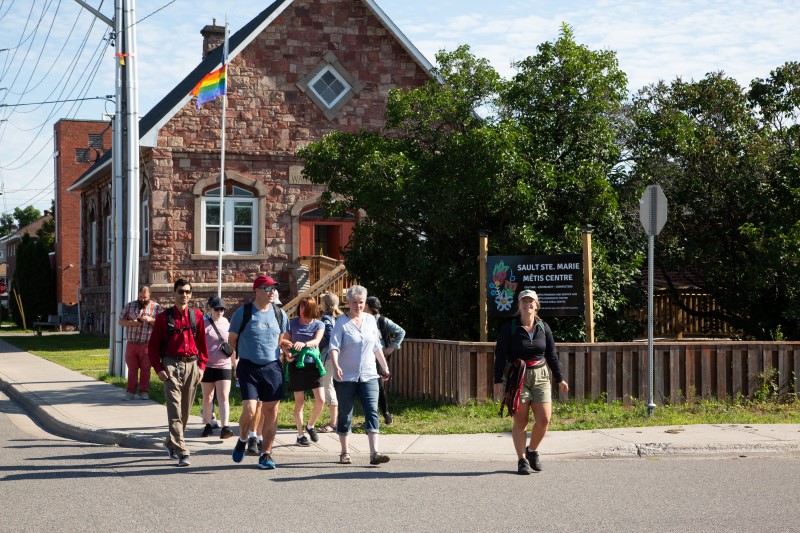
Guided Walking
Friday and Saturday mornings at 10:30 a.m.
Available late June–late September
Tours are 2 hours/5 km in duration
Cost is $50/adult or $25/student, group rate (max. 10 people) $350
Guided Walking & Paddling Tour
Thursday, Friday and Saturday evenings at 5 p.m.
Available late June–late September
Tours are 2 hours/7 km in duration
Cost is $90/adult or $45/student, group rate (max. 12 people) $675
All paddling safety equipment is included
Online Reservations
Individual and group reservations available. Learn more and book your tour now at Métis Tours.
Celebrate the 20th anniversary of the Supreme Court decision acknowledging the Metis Nation as a distinct Indigenous culture in Canada with a visit to the newly opened Métis Cultural Centre at 136 John Street.
By Tourism Sault Ste. Marie
Forest The Canoe are offering a variety of guided tours to see some of the best fall colours in Ontario. The True North Adventure Bus has full day, morning and evening guided tours running in September and October.
Witness the stunning fall colours you’ve seen on Instagram. Paddle beautiful inland lakes. Hike up the iconic Robertson Cliffs to witness a stunning vista of autumn colours that stretch as far as Lake Superior.
Contact experienced tour guides Forest The Canoe to see some of the most beautiful fall colours in Ontario. Ride the True North Adventure Bus this fall, with daily tours departing from Sault Ste. Marie.
Four fall colour tours are offered on the True North Adventure Bus, each a truly unique adventure, and a each chance to see and explore a different part of Northern Ontario. Tours last a full day, a morning or an evening with pick ups from local hotels in Sault Ste. Marie throughout the day.
Friends of Fall Colours
Explore the autumn colour change by water and land. Tours run 9.30am – 6.30pm.
Sunday, Sept 18th,
Friday, Sept 23rd,
Saturday, Sept 24th,
Sunday, Sept 25th,
Saturday, Oct 1st,
Sunday, Oct 2nd,
Wednesday, Oct 5th,
Friday, Oct 7th,
Friends of Fall Colours: Lite Edition
A micro version of Friends of Fall Colours. Tours run 4.30pm – 9.30pm
Wednesday, Sept 21st
Monday, Oct 3rd
Chase The Train
Chase the train all the way to Searchmont, then explore a beautiful waterfall on the Goulais River. Tours run 8am – 12.30pm.
Thursday, Sept 22nd
Monday, Oct 3rd
Tuesday, Oct 4th
Thursday, Oct 6th
Coastal Fall Colours at Sunset
Experience breathtaking views of Algoma Highlands along the greatest lake all the way to Montreal River. Tours run 5pm – 9.30pm
Thursday, Sept 22nd,
Monday, Sept 26th, Thursday, Sept 29th
Tuesday, Oct 4th,
Thursday, Oct 6th,
Sit back and enjoy the drive, that’s all you’ll have to do with the True North Adventure Bus. Expert, certified tour guides Ryan and Shana provide informative narration to help you get the most of your experience. Enjoy your day with all the quality equipment and safety information you will need.
By Sault Tourism
The Sault Ste. Marie Museum, located in the heart of downtown, houses a fascinating collection of historical exhibits that helps visitors learn about the history of the city all the way back to its earliest days. Check out the Edmund Fitzgerald display in the Marine Gallery, which includes a replica scale model of the famous ship. View historic photographs to see what our waterfront and downtown used to look like, and enjoy some of local sport history including the Soo Greyhounds!
The Sault Ste. Marie Museum though is not just a space curated to tell the history of the local area, it also hosts many fun and unique events, publishes a weekly podcast series, contains a gift shop, and has a new interactive feature utilizing QR codes, which adds video and audio information to many of the displays. Come for a visit when you are in the Soo!
The Sault Ste. Marie Museum is a heritage building constructed originally as a post office between 1904-1906 after the city received $20,000 in funding from the Dominion Government. Like many buildings in Sault Ste. Marie it used sandstone excavated during the construction of the canal, with the iconic clock tower being added in 1912. At this point the Museum, then the Post Office was the largest and grandest building in the City and became a local landmark, being the first sight of the city for approaching travelers.
Today visitors can enjoy the typically Ontarian eclectic architecture combining several styles including uniquely cut stone walls, Romanesque arched windows, magnificent oak stair case and an exquisite three-storey skylight, and the 110 year old clock tower remains an iconic landmark of downtown Sault Ste. Marie.
The Skylight Gallery, on the second floor, is a walkthrough history and the story of Sault Ste. Marie from its early beginnings to the present day. Displays feature artifacts and information on the first people in the area with a full sized Wigwam and early canoe offering fascinating insight into historic life. Other displays feature information on the local fur trade, mining and the lumber trade, which as the displays tells, in 1810 became the main export from Canada.
Moving into the twentieth century the museum has exhibits on healthcare including nursing as well as policing and fire management. Additional information including archived video and audio is available via a series of QR codes, including the one below, which adds an interactive component to any visit of the Sault Museum.
The Discovery Gallery is a fun and interactive, hands-on learning children’s area. It contains artifacts and features nature species, photographs as well as a dress-up area. This space is also used to host workshops, activities and events, more of which is mentioned later in this article.
On the third floor is the Music Gallery, which showcases Sault Ste. Marie musicians and venues through the ages. Bands and musical groups originated at the turn of last century during the days of silent movies, and Sault Ste. Marie had its fair share of entertainers. Sounds from these bands would commonly be heard emerging from the Algoma Theatre, Grand Opera House and the St. Marys River Boat Club. During the 1950s and 1960s when smaller Rock & Roll bands became fashionable, musical acts would perform in local Sault Ste. Marie bars including the Victoria House, The Royal, Lock City Hotel and more.
The Music Gallery houses a collection memorabilia, artifacts and videos from these eras and also contains ‘The Sault Music Project’, a giant binder of past and present Soo musicians!
The Marine Gallery offers a pictorial display of early Great Lakes cruise ships, a brief history of the Locks and scale models of two of the more storied Great Lakes ships, the Edmund Fitzgerald and the Chicora.
The Chicora was a British blockade-runner for the Confederate Army during the American Civil War. Her role was primarily to transport guns and ammunition from Bermuda to Charleston. After the war, the ship was transformed into an overnight passenger and freight vessel, and carried mail and passengers from Collingwood to Sault Ste. Marie. In 1870, the Chicora was again involved in a dispute with America when she was refused entry to the American locks and was forced to unload its army destined for the Red River Rebellion. This particular incident, as well as a general tension between the two countries, spurred the building of a Canadian canal in Sault Ste. Marie.
The Edmund Fitzgerald is perhaps the most famous ship to be associated with the Great Lakes, having sunk in a November storm in 1975 killing the entire crew of twenty-nine. A scale model, as well as information about the ship’s fateful timeline, can be viewed in the Marine Gallery of The Sault Museum.
The Sports Hall of Fame gallery depicts local athleticism from the 1800s forward and features artifacts and photos showcasing the wide variety of sports that represent our city. Check out the Eliason Motor Toboggan, and a special commemorative display for the 1948 NOHA champions, the Soo Greyhounds!
A video presentation highlights various sports and the people involved. The gallery is dedicated to Russell H. Ramsay, local sportscaster, president & general manager of Hyland Radio & TV. He served as an Alderman on city council and served as the MPP for Sault Ste. Marie 1978-1985.
This gallery, on the first floor, is dedicated to Lt. Col. Walter Wallace, past commanding officer of the 49th Field Regiment RCA, past president of Royal Canadian Legion – Branch 25 – and past president of the Sault Ste. Marie & 49th Field Regiment RCA Historical Society. Walter was a big advocate for museum later serving as president of the board of directors. He helped oversee the move of the historical Society’s collection to the museum in 1983.
The museum’s wartime collection includes a selection of diaries from 1914 to 1918, military medals and badges, trench art, photographs, and uniforms among other items.
SURVEYOR’S STAKE DATE: 1846
The stake was used by local surveyor Alexander Vidal. The large square wooden post, pointed at both ends of the stake, features carved lettering on all four sides to depict the direction from the stake in which each divided land plot would begin. It was used to dictate plots and streets based on Vidal’s surveying.
COMMEMORATIVE KEYS DATE: OCTOBER 28, 1954 & NOVEMBER 7, 1963
These two commemorative keys were presented to the Grey Sisters of the Immaculate Conception during two significant ceremonies in Sault Ste. Marie. The keys celebrated the grand opening of the General Hospital’s addition of the New Pavilion’s B Wing in 1954 and the Pavilion’s A and Y wing in 1963.
Located inside is also a great gift shop, the Clock Tower Gift Shop, which contains unique books about the area, local art works, craft works by local consigners and various locally made gifts and goodies!
Every Thursday, the Sault Museum publishes a podcast under the series titled ‘Stories of Northern Life’. This unique and fascinating series covers local history, tells important local stories, and from time to time has a Q&A with Museum experts and staff, where often-wondered questions like ‘Is the museum haunted?’ are discussed.
The Sault Ste. Marie Museum runs many unique and fun events and activities each week. Whether it’s a Prohibition Event with beer tasting and trivia, Murder Mystery nights, Scottish Highland dancing or one of the various paint nights including ‘Bad Art Club’ and ‘Star Wars Paint Night’. All the information about the various events can be found here!
For more information about this wonderful collection of local history, visit the Sault Ste. Marie Museum’s website.
And did you know that you can pick up a 4-Culture Attraction Pass on the Sault Tourism website? This Pass will give you 10% off admission to the Sault Ste. Marie Museum as well as the Canadian Bushplane Heritage Centre, the Ermatinger Clergue National Historic Site and the Art Gallery of Algoma. Click here and scroll down the page to learn more. Plan your cultural visit in Sault Ste. Marie today!
By Sault Tourism
Lake Superior Provincial Park Visitor Centre is located at the south end of ‘the Park’, as locals call it, roughly halfway between Sault Ste. Marie and Wawa, and just above the Montreal River. The drive up the coast from Sault Ste. Marie makes for a perfect daytrip, with several worthy stopping points along the way. More about this is available at the bottom of this article.
The park is known for its 150 km of maintained canoe routes, 11 hiking trails of over 130 km, fishing for Lake Trout, Rainbow Trout, Salmon, and backcountry camping. There are 163 backcountry campsites in Lake Superior Provincial Park which are divided into 76 zones. You can get all the information on it by visiting the website here.
The visitor centre is a great stopping point, with lots of information about the area, helpful staff and a fascinating recount of the history of Lake Superior.
As you enter the visitor centre you are greeted by a beautiful high-ceilinged room with an information desk, map of the area, notice board of daily information and bathrooms.
A short walk takes you a room filled with interactive displays that highlights the “Power of Lake Superior” as well as the park’s cultural history and natural ecosystems. You’ll also find a display about the Group of Seven, a replica lighthouse, plus there are large number of buttons and knobs for kids to press – perfect for a raining day activity for the little ones 🙂
The visitor centre is located on Agawa Bay beach, and there are some beautiful trails that lead to the water and the surrounding area. Located close to the entrance you’ll also find a Group of Seven easel, just one of many on the ‘Moments of Algoma’ Group of Seven Driving Tour.
Just behind the information desk there is a gift shop with lots of interesting souvenirs and apparel, and all Lake Superior themed of course.
A short drive north takes you to the Agawa Rock Pictographs. A clearly marked sign on the highway directs visitors to a parking area at the trail head – map coordinates here.
The trail to the site of the Pictographs is short but rugged; it contains slippery steps and rocks to climb over and around – so take care!
The Agawa Rock Pictographs is one of the most famous pictograph sites in Canada and is one of the most visited indigenous archaeological sites too. It is a sacred site where generations of Ojibwe have come to record dreams, visions and events. Please respect and preserve the pictographs by not touching the paintings.
The images visible today, include canoes and animals such as moose, deer, bear and caribou. The most recognizable painting consisting of a spined-horned animal said to be “Misshepezhieu”, or the Great Lynx, the spirit of the water. Read more about this important area here.
The Visitor Centre in the Provincial Park is just one stop of many on the beautiful Lake Superior coastal drive.
Heading south you may wish to make your next stop the Edmund Fitzgerald Lookout Trail in Pancake Bay Provincial Park. A beautiful view across a luscious maple forest all the way to the Superior coast reward those who hike the 6 km round trip. You may also see the final resting place of the Edmund Fitzgerald ship.
Beautiful souvenirs and ice-cream treats are available at Agawa Crafts and the Canadian Carver further south and The Voyageur Lodge also has some great souvenirs and food options. Chippewa Falls, the famed halfway point on the trans-Canada highway is a great spot for a break. The falls are right beside parking lot, just off the highway. Check out another Group of Seven art easel while you are there.
By Sault Tourism
The Edmund Fitzgerald lookout trail, in Pancake Bay Provincial Park, is the perfect day trip activity from Sault Ste. Marie.
Just an hour north of the city, it’s one of best lookout hikes in all of Ontario. A beautiful woodland walk through towering maple trees leads you to spectacular views of Lake Superior, as far out as the resting position of the Edmund Fitzgerald ship.
The lookout trail is located just a few minutes north of Pancake Bay Provincial Park along highway 17. There is ample parking located about a hundred metres off the highway. Click here for a Google Maps link to directions.
The trail, parking and trailhead are all within the park, so day-use fee applies. You can get your daily vehicle permits in advance online here – both Pancake Bay and Batchewana Bay are both currently offering the advance daily permit online. And of course by buying a day pass you can have a swim at the beach after your hike!
A clearly marked trail-head sign with route information and a map marks the start of the trail. The hike to the lookout and back is around 6km and takes 2-3 hours. Longer side routes are available taking you to Pancake Falls or Tower Lakes.
The route to the lookout is a mix of flat hiking through forests, with some occasional up hill sections. All trails are well maintained by Parks Ontario crew!
The trails are clearly marked with blue signs, and there are maps at each trail intersection. The trails is described a ‘moderate’ difficulty because there may be some scrambling over rocks or small branches.
The most strenuous part of the trail is the climb up the wooden stairs to the lookout itself…
TOP TIP – Spend a few minutes reading the information sign in the middle of the climb as a way to gather your breath before the final ascent.
There are a couple of lookouts before you reach the actual top… and when you reach the top the views are simply stunning.
It won’t take long before you’re back at your car, and a beautiful drive south back to Sault Ste. Marie awaits. Why not stop for an ice cream at Agawa Crafts and the Canadian Carver? They also have some fantastic souvenirs. The Voyageur Lodge also has some great souvenirs and food options. Chippewa Falls is a great spot for a break and the falls are right beside parking lot just off the highway. Check out the Group of Seven art easel while you are there.
Or maybe you’ll spend the drive planning your return trip in a different season…
Picture this view in the fall… 🙂